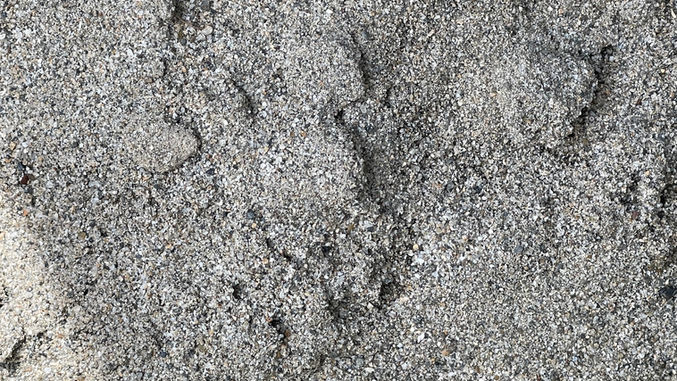取り扱い骨材
木曽川左岸、愛知県愛西市三和町地先において令和5年12月より砂採取開始しました。
「細砂」と言われる天然川砂のみの販売です。
用途:
砂場用砂、左官砂、生コンの骨材、テトラポット用骨材、地盤改良材、アスファルト合材や透水材、水濾過材、バンカー砂 等
JIS A 5308
ふるい分け試験結果(通過率百分率)
2.36mm (80-100)100 (%)
1.18mm (50-90) 99.9 (%)
0.600mm (25-65) 96.4 (%)
0.150mm (10-35) 17.6 (%)
0.075mm 4.2 (%)
JIS A 1104
単位容積質量 1.496 t/㎥

濾過砂としての条件
有効径
急速用ろ過砂では0.45~0.70mm
緩速用ろ過砂では0.30~0.45mmの範囲にあること
大径は2.0mm以下
最小径は急速用ろ過砂では0.3mm以上
緩速用ろ過砂では0.18mmであること
硬度について
石英の含有率が平均74%あるのでとても堅い砂となります。

River sand is typically composed of high-purity quartz (SiO₂), with minor contributions from feldspar, mica, and clay minerals. The chemical composition reflects the upstream geology and erosion processes. In some cases, iron oxides (Fe₂O₃) and aluminum oxides (Al₂O₃) are present in measurable quantities.
木曽細砂は水濾過材としての使用に耐えられる硬度を持ち、
粒度も急速濾過寄りの緩速濾過砂としての性能を持つ川砂です。
長い時間をかけて御嶽山から流れてきているので石の中に含まれるナトリウム分が溶け、その部分がえぐれて痘痕のような形となっている特殊な形状の川砂です。
緩速濾過は微生物の力で水を濾過する仕組みなので別名:生物濾過とも言われ始めています。(海外ではバイオフィルターという表現を使われたりしています)痘痕状の砂なので微生物の繁殖しやすい環境を維持できると考えられる特殊な砂となります。
🏞️ 特徴:木曽川砂の組成と性質
🔬 主な鉱物組成
-
石英(Quartz):透明で硬く、耐久性が高い。砂の主成分。
-
長石類(Feldspar):斜長石・カリ長石などが含まれ、石英とともに砂の約2/3を占める。
-
重鉱物(Heavy Minerals):
-
チタン鉄鉱(Ilmenite)などの鉄-チタン鉱物が最多(約43%)
-
輝石類・角閃石などの火成岩由来鉱物
-
ジルコン(Zircon)も約5%含有
-
その他:黒雲母、モナズ石、アルミノ珪酸塩など
🪨 岩石の由来
-
美濃帯の堆積岩(ジュラ紀~白亜紀):砂岩・泥岩・チャートなど
-
火成岩類:
-
流紋岩(濃飛流紋岩):岐阜県~富山県に広く分布
-
安山岩:御岳山の噴火由来
-
花崗岩類:領家帯(白亜紀~古第三紀)に由来
-
-
変成岩:
-
泥質ホルンフェルス:泥岩が高温変成を受けて硬化した岩石
🧪 微細構造と特性
-
石英は変質に強く、滑らかな表面を持つ
-
長石は変質により内部が曇ったような見た目になる
-
砂岩は「アレナイト質砂岩」と呼ばれ、長石の割合が多い
木曽砂は御嶽山を中心とした火山活動・堆積・変成作用など多様な地質プロセスを経て形成された、非常に豊かな鉱物組成を持つ天然資源です。泥分が少なく建設資材としての強度や耐久性に優れ、資源としての価値も高く軽石のような形状である川砂なので透水性だけでなくグリップ力があるため30cm厚さまでであれば乗用車の走行ができる特徴を持っています。木曽砂でも特に透水性が高い性質を持っています。
Technical Description of Kiso River Sand (Kiso-suna)
Geological Origin and Composition
Kiso River sand is a naturally occurring sediment derived from a complex geological background, primarily shaped by the Mino Belt accretionary complex and surrounding igneous and metamorphic formations.
Mineral Composition
-
Quartz: Dominates the sand fraction, known for its hardness and chemical stability.
-
Feldspars: Includes plagioclase and potassium feldspar, often altered and cloudy due to weathering.
-
Heavy Minerals:
-
Ilmenite (FeTiO₃): Most abundant heavy mineral (~43%)
-
Pyroxenes and Amphiboles: Indicative of volcanic origin
-
Zircon: Present at ~5%, useful for provenance analysis
-
Others: Biotite, monazite, and alumino-silicate minerals (e.g., Al₂SiO₅), often linked to contact metamorphism
Rock Sources
-
Sedimentary Rocks: Sandstone, mudstone, and chert from the Jurassic–Cretaceous Mino Belt
-
Igneous Rocks:
-
Rhyolite: From the Nohi Rhyolite formation, a welded tuff of acidic volcanic origin
-
Andesite: Derived from volcanic activity around Mt. Ontake
-
Granite: From the Ryoke Belt (Cretaceous–Paleogene), contributing feldspar-rich fragments
-
-
Metamorphic Rocks:
-
Hornfels: Formed by contact metamorphism of mudstone, resulting in dense and hard textures
-
Cordierite-bearing hornfels: Indicator of low-pressure, high-temperature metamorphic conditions
Petrographic Features
-
Sandstone grains are classified as feldspathic arenite, with feldspar content exceeding quartz.
-
Quartz grains show undulatory extinction and embayment structures, indicating volcanic origin and phase transitions (β- to α-quartz).
-
Feldspars exhibit signs of chemical alteration, such as cloudiness and surface etching.
木曽細砂の販売しています。取り扱い希望の方は組合員、特約販売店又は特約代理店までお問い合わせください。







